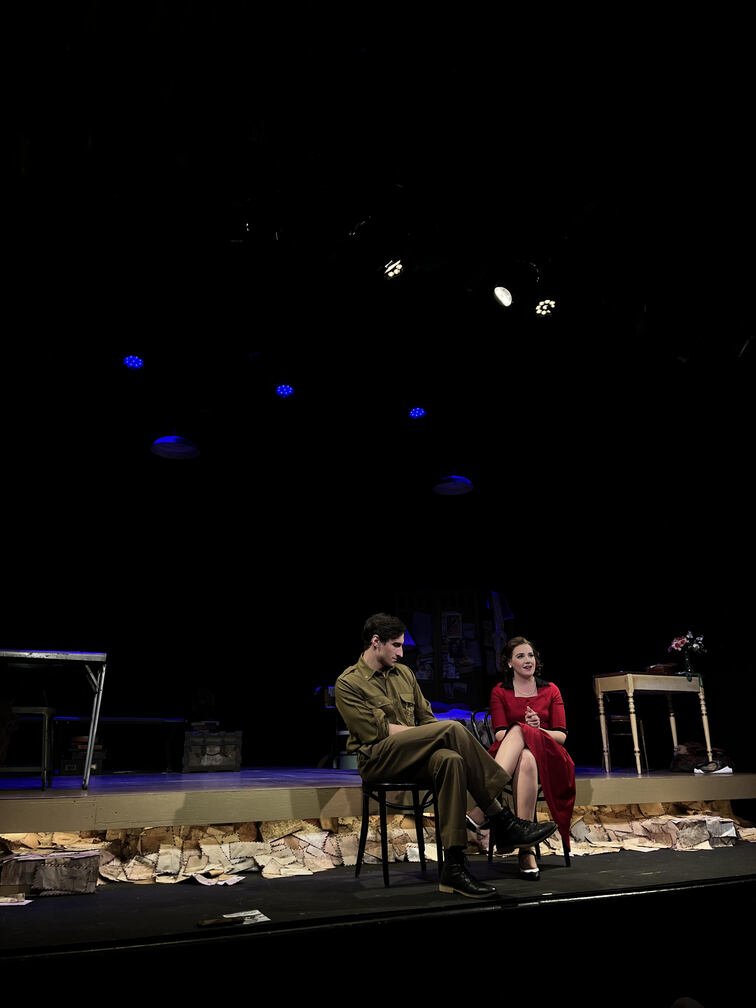Thousands of letters literally set the stage at Penguin Repertory Theater for Ken Ludwig’s newest play Dear Jack, Dear Louise. Audiences followed the titular Jack and Louise, played by Michael Liebhauser and Alexandra Fortin respectively, from 1942 to 1945 as they communicate by post from across the country and eventually across the globe.
What was once a hay barn underwent a transformation 47 years ago into a warm, rustic space which provided a fitting atmosphere for Penguin Rep Theater’s latest production. The historic nature of this 1880 barn, as well as a distinctly American architecture style, lends itself easily to this World War 2 period piece. The raked seating leading to the proscenium stage draws audiences’ eyes towards the minimalistic cast and the impeccably crafted stage.
Christian Fleming, scenic and costume designer, has done an incredible job specifically with his scenic design on this piece. The foundation of the entire play rests upon the millions of words of Jack and Louise pouring out from under their feet as they come to know and love one another. On this raised platform above the plethora of airmail ubiquitous with the 1940s are two distinct environments. On the audience’s left hand side is Jack’s domain, a brutal Army camp that is smacked with harsh, cool toned light that emphasizes the sterile environment he occupies. The right hand side is Louise’s colorful and comfortable room in a Manhattan boarding house. Louise’s surroundings are bathed in soothing, warm toned hues that match not only her effervescent personality, but her protection from the most immediate effects of wartime.
The actors seldom left their distinct spaces, which in turn sets up one of the most poignant moments in the show. As Louise heads off with a traveling theater company, she invades Jack’s spartan room. It is all rigid angles and dull Army green, yet as Louise speaks she unveils a silky lilac robe trimmed with ivory lace edges. She discards her shoes and pads barefoot to the corner of the stage where she gingerly hangs up the robe amongst Jack’s Army fatigues. One simply cannot tear their eyes away. However, audience members must look away to witness Jack. His lanky form is sprawled out on Louise’s chaise lounge in those same forest green Army fatigues, and his fingers busy themselves by fiddling with one of Louise’s letters. On that rosy chaise lounge he lies under siege by a multitude of rich fabrics and the detritus of 1940s femininity. It is almost laughable to see him surrounded by colorful heels, hatboxes, discarded dresses and pinned photos of movie stars. Jack speaks of living with a family in England who has never heard of Thanksgiving, and the jovial mood slowly dissipates. Audiences are starkly reminded of how much he must long for his physical and cultural home and the privilege to fully enjoy the plush comforts of daily civilian life.
Dear Jack and Dear Louise clearly resonated with its audience. During the talkback portion of the evening, a man identified himself as a “1930’s baby” and complimented the cast and crew for capturing the tension and uncertainty that came with living through the era. Through powerful emotion that sent shockwaves through the audience, he expressed immense gratitude towards Liebhauser and Fortin for how they “bring it all back”. Liebhauser and Fortin deserve their flowers, yes; but I argue that the technical elements are what sincerely allowed these performers to shine and the audience to be transported to another time.


You must be logged in to post a comment Login